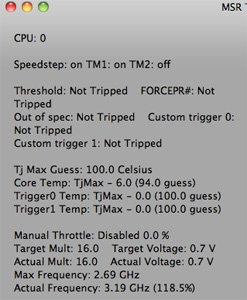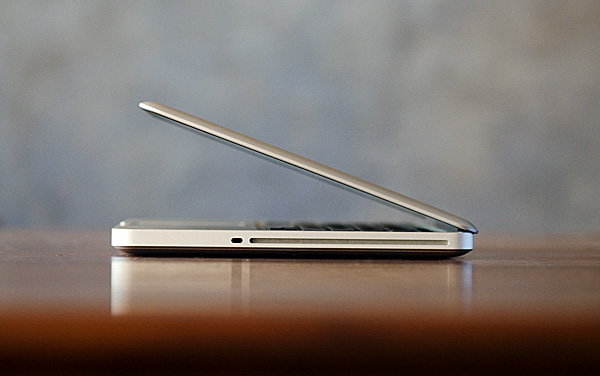The MacBook Pro Review (13 & 15-inch): 2011 Brings Sandy Bridge
by Anand Lal Shimpi, Brian Klug & Vivek Gowri on March 10, 2011 4:17 PM EST- Posted in
- Laptops
- Mac
- Apple
- Intel
- MacBook Pro
- Sandy Bridge
What About The 13?
Apple's new 13-inch MacBook Pro received the biggest upgrade of the lot. Last year Apple opted against moving the 13-inch model to Arrandale and instead gave it a beefy GPU and a mildly evolved Core 2 Duo CPU. The presumed public reasoning was Apple didn't like Arrandale's GPU performance and needed a two chip solution to maintain the platform's size hence the NVIDIA GT 330M + Intel Core 2 Duo setup. Internally I'm wondering if there was a small amount of corporate politics being played there. Apple used to get a discount on Intel CPUs in exchange for exclusivity, that agreement expired with Nehalem. When Nehalem hit, Apple had to pay the same price as everyone else for CPUs. Now does the 2010 Core 2 based 13-inch MacBook Pro make more sense? Keeping Intel's flagship CPU out of Apple's highest volume MacBook Pro had to hurt. I wonder if Apple got discounted pricing on Sandy Bridge as a result...
| Evolution of the 13-inch MacBook Pro | Early 2011 | Mid 2010 | Late 2009 |
| CPU | Intel Core i5 2.3GHz (DC) | Intel Core 2 Duo 2.40GHz (DC) | Intel Core 2 Duo 2.26GHz (DC) |
| Memory | 4GB DDR3-1333 | 4GB DDR3-1066 | 2GB DDR3-1066 |
| HDD | 320GB 5400RPM | 250GB 5400RPM | 160GB 5400RPM |
| Video | Intel HD 3000 (integrated) | NVIDIA GeForce 320M (integrated) | NVIDIA GeForce 9400M (integrated) |
| Optical Drive | 8X Slot Load DL DVD +/-R | 8X Slot Load DL DVD +/-R | 8X Slot Load DL DVD +/-R |
| Screen Resolution | 1280 x 800 | 1280 x 800 | 1280 x 800 |
| USB | 2 | 2 | 2 |
| SD Card Reader | Yes | Yes | Yes |
| FireWire 800 | 1 | 1 | 1 |
| ExpressCard/34 | No | No | No |
| Battery | 63.5Wh | 63.5Wh | 60Wh |
| Dimensions (W x D x H) | 12.78" x 8.94" x 0.95" | 12.78" x 8.94" x 0.95" | 12.78" x 8.94" x 0.95" |
| Weight | 4.5 lbs | 4.5 lbs | 4.5 lbs |
| Price | $1199 | $1199 | $1199 |
While the 15-inch MacBook Pro is quad-core only, the new 13 is strictly dual-core. You get two options: a 2.3GHz or 2.7GHz dual-core Core i5 or Core i7. In Intel speak it's the Core i5-2410M or the Core i7-2620M (it's no wonder Apple doesn't list model numbers for these things).

The 2011 13-inch MacBook Pro Motherboard
| Apple 13-inch 2011 MacBook Pro CPU Comparison | ||||
| 2.3GHz dual-core | 2.7GHz dual-core | |||
| Intel Model | Core i5-2410M | Core i7-2620M | ||
| Base Clock Speed | 2.3GHz | 2.7GHz | ||
| Max SC Turbo | 2.9GHz | 3.4GHz | ||
| Max DC Turbo | 2.6GHz | 3.2GHz | ||
| GPU Base Clock Speed | 650MHz | 650MHz | ||
| GPU Max Turbo | 1.2GHz | 1.3GHz | ||
| L3 Cache | 3MB | 4MB | ||
| AES-NI | No | Yes | ||
| VT-x | Yes | Yes | ||
| VT-d | No | Yes | ||
| TDP | 35W | 35W | ||
The primary differences between these two parts are clock speed, L3 cache size and AES-NI support once again. The 2.3GHz Core i5 lacks AES-NI, has a 3MB L3 cache and can only turbo up to 2.9GHz. The 2.7GHz Core i5 has AES-NI, a 4MB L3 cache and can turbo up as high as 3.4GHz.

I verified turbo frequencies on the 2.7GHz 13-inch. The highest I saw single core turbo hit was 3.4GHz, and dual core turbo was good for 3.2GHz. There's absolutely no funny business going on here, the dual-core 2.7 is allowed to hit its maximum frequencies.

You'll notice that the 2.7GHz DC chip has the same max single core turbo as the 2.3GHz QC chip from the upgraded 15-inch MacBook Pro. In practice this means that for light workloads the upgraded 15 won't feel any faster than the 13 (or that the 13 will feel as fast as the 15 depending on how you look at it). I'm talking about things like web page load times and application launch/install times. There may even be a slight performance advantage for the 13-inch setup as it's able to turbo up to higher frequencies easier than the quad-core 15. Crank up the threads and you've got a different story entirely of course. There's no replacement for more cores on highly threaded workloads.











198 Comments
View All Comments
iwod - Friday, March 11, 2011 - link
iPad is only just starting to sell and iPhone still has lots of space to grow. The trend is Apple are making more units and more money from ARM specific products.Nvidia has just recently stated that Project Denver will be ARM 64 bit. And aiming at HPC and Desktop. Full Compatible with current ARM instruction set.
Currently Apple must have a ARM version of Lion testing, and few years down the road, they could switch their Mac over to ARM 64 bit. Using a single Instructions Set for their whole product line.
For some reason i have been thinking that Apple and Intel aren't doing too well together like anand has felt. I dont think Thunderbolt is any indication of their current relationship. it is merely they have been working on it for such a long time, no one wants to lose our at the end.
Of coz it could have been the other way round x86 moving into iPhone, although that depends how much intel is willing to bend towards apple.
jbh129 - Friday, March 11, 2011 - link
Anand,Can you guys run your high-end 15 through the Windoze tests that were used on the 13?
Thanks
tajmahal42 - Friday, March 11, 2011 - link
Hello guys!First, I have to say this review is really awesome, as usual! Just what I was hoping for. The thoroughness and practical sense of your reviews continues to amaze me every single time.
For the 13" MBP, you mention "bouts of instability". Can you elaborate on that? Stuttering? Crashes? In what way do you notice that instability? I'm a little concerned now.
tno - Friday, March 11, 2011 - link
+1alent1234 - Friday, March 11, 2011 - link
my wife has been bugging me about our wifi since we moved and get a poor signal in a lot of the new apartment. told her i can get a new router with 3 antennas but we will also need a new laptop as well with the antennas to take advantage of it.which brings me to my question. i know the 15" model has the 3 antennas. does the 13" do MIMO as well?
tipoo - Friday, March 11, 2011 - link
They all use the new card.By the way, have you tried switching wifi channels, or installing DD-WRT and boosting signal? Even so, you don't need a new laptop after getting a new router if signal strength was the only problem.
alent1234 - Friday, March 11, 2011 - link
i'll try that, thxa lot of wifi around me these days. we only have work laptops now so that would be our only personal computer if we bought one. i was looking for the cheap SB models when they come out
name99 - Friday, March 11, 2011 - link
"told her i can get a new router with 3 antennas but we will also need a new laptop as well with the antennas to take advantage of it."This is not completely true. A base station with multiple antennas CAN do the equivalent of phase-array beam steering to direct most of the output power towards the target laptop. The laptop will thus see a stronger signal, and one of the better modulation schemes (eg 64-QAM 5/6) can be used rather than one of the weaker schemes. Thus your laptop, even if it has only one (or two) antennas can still see better performance.
Note, this is a theoretical possibility. I do not know the current state of the art in how well base stations utilize the various forms of transmit diversity that are available. And no review ever seems to talk about this stuff, either by testing how well the kit works with a single antenna device, or by talking to the manufacturer about what's in their product.
Brian Klug - Friday, March 11, 2011 - link
The 13" does have 3x3 MIMO as well, the exact same broadcom solution as the 15" I tested extensively.-Brian
7Enigma - Friday, March 11, 2011 - link
Anand and crew,I am very disappointed with the battery life numbers in this review. This is the first review of a laptop where it appears you have used a 3rd party app (Cody Krieger's gfxCardStatus tool) to significantly inflate the numbers of the new 2011 systems. 35-60% by your own numbers back on the discrete GPU battery life page, which you then fail to report in the battery life tables later on!
When you are tasked to review a system (especially an Apple product I might add) it should be reviewed as is, with no tweaking or 3rd party add-ons to boost performance/benchmarks. When have you EVER installed an add-on for a Windows-based laptop to improve performance/life? I can't think of one.
At best this was a simple oversight where you have benchmark numbers WITHOUT the gfxcardstatus, at worst this was a cover-up job which I have always argued in the forums against and on your site's behalf.
Please update the tables to show what a stock newly-purchased laptop at the Mac Store would deliver.
I am very disappointed in this coverage.